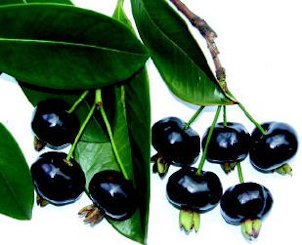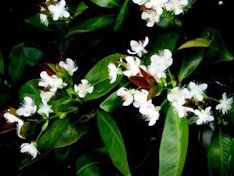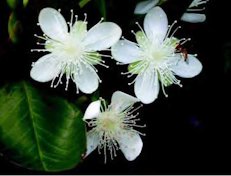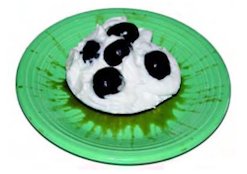From the Twelve
Fruits With Potential Value-Added and Culinary Uses
by Ken Love, Richard Bowen, and Kent Fleming
Grumichama
Scientific name: Eugenia brasiliensis Lam.
Family: Myrtaceae
Synonyms: Eugenia dombeyi
(Spreng.) Skeels, Myrtus
dombeyi Spreng., Stenocalyx
brasiliensis O. Berg
Origin: Southeastern Brazil

Grumichama,
also called Brazil cherry and Spanish cherry, is an attractive tree
growing up to 45 feet tall with thick, waxy, oblong, deep green,
3–4-inch leaves. The tree can be pruned as a shrub and kept at
6-foot heights to facilitate harvesting. In Hawai‘i it produces
fruit from 300 to 2000 feet elevation. Mature flowering trees are
reminiscent of Japanese cherry trees, producing thousands of white
four-petaled flowers, each with about 100 white stamens and yellow
anthers. The long-stemmed fruit is 1⁄2–1 inch in diameter
and turns from green to red to dark purple and black as it ripens. One
variety produces a yellow fruit. The fruit’s thin, fragile skin
holds juicy white to red pulp and one to three small gray seeds. The
aromatic flavor is like a sweet, subacid cherry with a hint of
jaboticaba.
A member of the Myrtaceae family, grumichama is
related to guava, jaboticaba, mountain apple, and other members of the
genus Eugenia, which includes more than 30 species with edible fruits.
The tree was first reported in Hawai‘i in 1821 in Don Francisco
de Paula Marin’s journal. Grumichama may have arrived here as
early as 1791.
 |
 |
| Grumichama
flowers |
Close up of inflorescense |
Cultivars
There
are no cultivars reported, but a number of differences have been
observed in seedling trees in Kona and Puerto Rico. Three types have
been distinguished based on differences in the firmness of the pulp,
the number of sepals, and the color of the fruit and pulp. There are no
discernible differences in flavor.
Environment
Grumichama
is a subtropical plant that grows best in partial shade but will
produce fruit in full sun. Fruit production is best when annual
rainfall is above 70 inches; supplemental irrigation can be used where
rainfall is lower. The tree prefers deep soils but will survive shallow
sandy soils when given enough moisture. Fruit production generally
begins in the fourth year from seedling trees that are about 4 feet
tall. The trees will grow about 1 foot per year but can be kept pruned
as a hedge and still produce abundant fruit. Given enough moisture,
trees at elevations from 250 to 900 feet tend to produce more fruit
than those at higher elevations, although leaf growth appears to be
about the same. Other than that, seasonal changes and
Hawai‘i’s microclimates have little effect on the tree as
long as it has sufficient moisture. Numerous seedlings are often found
under abandoned trees. The tree is well known for the speed at which
the flowers develop into fruit. Depending on the elevation and
rainfall, flowering occurs in May–July, with fruit being ready to
harvest 3–4 weeks after flowering.
Horticulture
Although
there is some commercial cultivation in Brazil, grumichama is still
regarded more as a backyard tree when left to grow tall. Cultivated
trees can be maintained at heights of 10 feet or less to facilitate
harvesting. Trees can be planted at 15–20 foot spacing or grown
at closer spacing in hedgerows, which although attractive tend to
produce less fruit than trees spaced at 15 feet.
Apply 1⁄4
pound of organic 6-6-6 fertilizer four times per year until the third
year of growth, then switch to 1⁄4 pound of 8-8-8 and increase
the amount commensurate with growth. Fertilizer should be applied
around the drip line. Twice-yearly applications of compost or mulch
will help growth. Micronutrients should be applied as needed. Care
should be taken not to over-fertilize, which suppresses flowering. The
tree is tolerant of a wide range of soils that are well drained.
Sufficient water is essential, especially during flowering and fruit
development. One-year-old trees in a dry location at 350 feet
elevation, which received 10 minutes of daily irrigation with a
1⁄2-gallon/hour emitter, showed more growth than trees without
irrigation. As with most Eugenia species, grumichama requires a little
pruning for keeping the desired height or shaping and removing dead
wood. Weed control is crucial during the first few years of growth.
Mulching with organic materials or black polyethylene sheets reduces
weed growth. Young, shallowrooted trees require protection from strong
winds.
Pests and
diseases
There
are no serious disease problems with grumichama when proper cultural
practices are employed. It is considered a host for fruit flies.
Following the guidelines established by the Hawai‘i Area-Wide
Fruit Fly Pest Management Program (HAW-FLYPM) greatly reduces the
number of infestations. Birds remain the largest problem for growers of
the fruit. Some Brazilian growers use netting to keep birds from the
tree. Mylar tape, Christmas tinsel, and used CDs hung from the tree can
help minimize bird damage. For many culinary applications where the
fruit will be processed or cooked, it can be harvested when red, before
birds are attracted to the sugars that develop in the dark purple,
fully ripe fruit.
Propagation
Generally grown from seed, grumichama can be grafted or cloned by
air-layer and cuttings. Seeds remain viable for up to 6 weeks.
Harvesting
and yield
The
harvest season is short, with fruits ripening over a 2-week period from
May to July, depending on elevation. The thin-skinned grumichama fruit
is delicate, and care needs to be taken when harvesting and packaging
fresh fruits for commercial sales. Placing fruits in 1-pint containers
in no more than a double layer prevents damage and maintains
attractiveness. Keeping the stem on the fruit is difficult but helps to
prevent desiccation. The fruit is marketable for 10–12 days after
harvest. Mature, 10-foot-tall trees can yield more than 50 pounds of
useable fruit. Mature trees kept pruned at 6 feet should yield about 30
pounds of fruit. Approximately 6 pounds of fruit can be processed into
8 cups of puree.
Postharvest
quality
The
fruits should be refrigerated as soon as possible after harvest.
Samples harvested, packaged, and chilled within an hour maintain
appearance and quality for 12 days. Samples left in open air for 5
hours before refrigeration (at 36°F) maintained quality for only 5
days. Fruits should be utilized as soon as possible after harvest.
Processed puree can be frozen for future use, although some loss of
flavor has been reported.
Packaging,
pricing, and marketing
For
grocery and restaurant distribution, plastic containers with single and
double layers of fruit were tested with no discernable differences.
Given the sensitivity of the fruit and skin, larger packages are not
recommended, as the weight of multiple layers of fruit will damage the
skin and cause indentations that make the fruit less desirable when
used in displays. As many chefs and produce buyers in Hawai‘i are
not familiar with grumichama, it is advisable to offer samples as well
as information on the fruit. Fruit availability is generally for only 2
weeks of the year, and advance notice given to buyers will help in
generating sales. Having a good working relationship with chefs and
wholesale buyers will ensure that the fruit does not go to waste.
Culled and excess fruits can be processed in a certified kitchen for
future use. Many island chefs prefer to work with frozen puree.
Fresh
fruit in plastic blister packs sold for $7.00 per pound to hotel and
restaurant chefs. Wholesale buyers and grocery store buyers paid $4.50
to $5.50 a pound. Processed puree in 8-cup packages sold for $50.00. An
8-cup package can yield approximately 24 4-oz jars of jelly with a
wholesale value of about $100.00.
Grumichama “clam-shell” fruit pack for retail
sale
Food uses and
nutrition
Grumichama
is generally eaten fresh. Chefs have used it in buffet lines and as an
edible decoration on plates. The taste has been described as a cross
between black cherry and jaboticaba with a hint of Concord grape.
Grumichama jelly and syrup can be found at some of
Hawai‘i’s farmers’ markets. In the Caribbean, a
reduction made from the juice of the fruit is used to accompany fish
dishes. It can also be used as base for hot sauces.
Whole pitted
fruits can be used in pies, cakes, and fruit salads. Processed puree is
used in jam and jelly or in sauces. The pulp is juicy with a dry
“grape like” skin.
Average
degrees Brix
18 (10 samples from three trees at three elevations)
Fruit flavor
(scale: 0 to 5)
Sweet to sour, 1.5 Bitterness, 0.5; with skin, 2 Astringency, 0.5; with
skin, 2.25
Nutritional value per 100 g of edible portion*
| Moisture |
84
g |
| Protein |
0.3
g |
| Fiber |
0.6
g |
| Ash |
0.43
g |
| Calcium |
39.5
mg |
| Phosphorus |
13.6
mg |
| Iron |
0.45 mg |
| Carotene |
0.039
mg |
| Thiamine |
0.044
mg |
| Riboflavin |
0.031
mg |
| Niacin |
0.336
mg |
| Ascorbic
acid |
18.8
mg |
| Carbohydrate |
13.4
g |
| Fat |
0.3
g |
| Vitamin
A |
67 UI |
*Values compiled from various sources

Grumichama tart with lilikoi sauce
About
the Twelve Fruits
With Potential Value-Added and Culinary Uses Project
Back to
Grumichama
Page
|
© 2007, University of Hawai'i
|
Bibliography
Love, Ken, et al. "Grumichama." Twelve Fruits With Potential
Value-Added and Culinary
Uses, University of Hawai'i at Mānoa, College of
Tropical Agriculture and Human Resources, 2007.
Accessed 17 Apr. 2016.
Photographs
Love, Ken. "Grumichama." Twelve Fruits With Potential Value-Added and Culinary
Uses, University of Hawai'i at Mānoa, College of Tropical
Agriculture and Human
Resources, 2007.
Accessed 9 Mar. 2016.
Published 9 Mar. 2016. Last update 17 May 2024 LR
|




